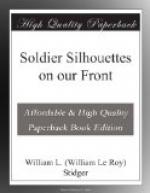There has been a good deal of discussion over a certain book entitled “I Accuse.” I never saw that finger pointing into the sky as we drove through this village that it did not cry out to the heavens and across the short miles to the German Huns, looking down, as it did, at its feet where the ruined homes lay, the village that it had mothered and fathered, the village that had worshipped within its simple walls, the village that had brought its joys and sorrows there, the village that had buried the dead within its shadows, the village that had brought its young there to be married and its aged to be buried; there it stood, night after night, against the crimson sky sometimes, against the golden sky at other times; against the rose, against the blue, against the purple sunsets; and ever it thundered: “I accuse! I accuse! I accuse!”
Then there is that Silhouette of Sacrilege up on the Baupaume Road. This is called “the saddest road in Christendom,” because more men have been killed along its scarred pathway than along any other road in all the world. Not even the road to Calvary was as sad as this road.
Along this road when the French held it, during the first year of the war, they gathered their dead together and buried them in a little cemetery. Above the sacred remains of their comrades these French soldiers erected a simple bronze cross as a symbol not only of the faith of the nation, but a symbol also of the cause in which they had died.
A few months later when the Germans had recaptured this spot, and it had been fought over, and the bronze cross still stood, the Hun, too, gathered his dead together and buried them side by side with the French. Then he did a characteristic thing. He got a large stone as a base and mounted a cannon-ball on top of this stone, and left it there, side by side with the French cross.
Whether he meant it or not, his sacrilege stands as a fitting expression of his philosophy, the philosophy of the brute, the religion of the granite rock and the iron cannon-ball.
He told his own story here. Side by side in those two monuments the contrast is made, the causes are placed. One is the cause of the cross, the cause of men willing to die for brotherhood; the other is the cause of those who are willing to kill to conquer.




